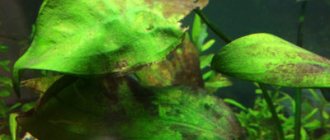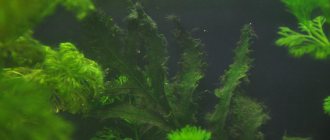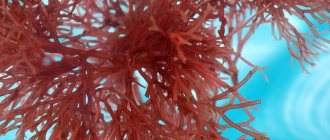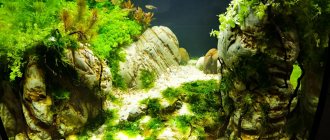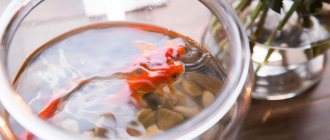One of the problems that aquarists often encounter is the growth of algae on the ground, decorations, glass and plant leaves. Different types of lower plants can settle in an artificial reservoir. One species that is often found in newly started tanks is brown algae (diatoms). Brown algae in an aquarium cover all surfaces with a slimy film and interfere with the normal functioning of higher plants, so when they appear, it is necessary to immediately begin measures to get rid of pests.
What happens?
Black plaque: causes and how to remove
It can appear in the form of mucus when a plant rots or a fish dies and decomposes.
To get rid of black slime, you need to find and eliminate the source of the decomposition, as well as change the water in the aquarium. There is also an algae called Blackbeard. When they appear, they form a low bunch of dark threads. If Blackbeard is not detected immediately, it will spread throughout the aquarium very quickly. The danger of this algae is that it grows into the cells of the substrate, and does not simply attach to it.
Reasons for the appearance of black plaque:
- Excess waste in the aquarium (food residues, fish waste, dead plant particles);
- Overpopulation of the aquarium. The more inhabitants there are, the more organic waste is generated;
- Insufficient filtration or dirty filters;
- With strong aeration, particles of sludge from the bottom are transferred to the plants and walls of the aquarium. The same problem can arise when keeping burrowing fish (for example, catfish) that get their food in the ground.
How to get rid of it?
It is necessary to remove all affected parts from the aquarium. Decorations and equipment can be placed in a solution of Whiteness (1:20) for 10-15 minutes, then rinse thoroughly under running water. It is better to boil the soil and driftwood; At the initial stage of the appearance of black plaque, you can fight it on objects or plants without removing them from the aquarium
To do this, you need to take 5 ml of hydrogen peroxide into a syringe and spray it on the affected areas, after turning off the aeration system;
Attention! A high concentration of hydrogen peroxide is harmful to fish and thin-leaved plants, so you should not abuse this method
Specialized stores sell products to combat black plaque and black beard. This method is considered the fastest
The rules of use will depend on the composition of the drug.
Brown plaque
The reason for the appearance of brown plaque is an increased increase in the number of brown diatoms.
It often happens that a brown coating forms during the first time after starting a new aquarium. But after a couple of weeks, when biological equilibrium is established, the plaque disappears. In an old aquarium, a brown coating appears due to:
- insufficient lighting;
- overfeeding fish (uneaten leftovers are an excellent breeding ground for bacteria);
- excessive use of plant fertilizers;
- insufficient amount of vegetation in the aquarium.
To get rid of brown plaque, in addition to eliminating the above reasons, weekly water changes and soil cleaning will help.
White plaque
White plaque does not cause significant harm to the aquarium and is very easy to remove. Plaque forms in the form of shapeless lumps of mucus, which are colonies of bacteria. White plaque can be found on any part of the aquarium (on glass, stones, plant leaves, decorations, soil). The reason for its appearance is the remains of rotting food at the bottom of the aquarium.
How to clean white plaque?
- remove organic debris (fish waste, food debris and dead parts of plants);
- rinse the filters under running water without using detergents;
- avoid overfeeding fish and overpopulation;
- wait until the biological balance is restored and the plaque disappears.
Green plaque
Why does green plaque appear and what to do about it? It is important to know that green algae is part of the microflora of the aquarium. But the creation of certain conditions provokes an outbreak of their growth until plaque forms on glass, soil and plants, and the water itself acquires a green tint.
Causes of plaque formation:
- placing the aquarium in direct sunlight and keeping it at elevated temperatures;
- excessive feeding of fish;
- accumulation of organic debris.
How and with what to wash? To remove plaque, you need to transplant the fish into a temporary container, drain the water, clean the walls of the aquarium and decorative elements with a special scraper under running water and refill the aquarium.
Limescale
This type of deposit forms on the walls of the aquarium as the water evaporates.
Causes:
- use of hard water;
- lack of vegetation in the aquarium;
- absence of a filter or its poor quality;
- insufficient or irregular care.
The easiest way to remove limescale is mechanical cleaning using a special scraper (you can use the hard side of a kitchen sponge).
Important! Metal scrapers should not be used, because... at the same time, metal particles get into the water, which over time begin to rust and harm the fish
You can also easily scratch the walls.
Prevention
In order to prevent the appearance of brown plaque on plants, it is necessary to maintain conditions in the artificial reservoir that are not suitable for the existence of algae:
- observe the light regime;
- maintain the temperature at a high level, and acidity and hardness at a low level;
- avoid overcrowding the aquarium and overfeeding the fish;
- regularly clean the tank (including the walls, if brown deposits appear on the glass) and change the water;
- monitor the quality of filtration and aeration;
- do not apply fertilizer in excess;
- plant the aquarium with fast-growing plants;
- introduce hydrobionts that feed on algal fouling.
In addition, it is necessary to carry out with caution all manipulations that can disrupt the biobalance.
Fighting methods
Algae in an aquarium.
To destroy a colony of algae that has settled on the leaves of underwater plants, glass or the bottom surface, you need to act radically:
- Transfer the underwater inhabitants to another aquarium. Remove all plants.
- Drain the water.
- Remove the soil, rinse it with running water, boil it or keep it in the oven at a temperature of +250...+300°C.
- Remove plaque and disinfect stones, driftwood and decorations.
- Clean the inner walls with a scraper, disinfect with a solution of potassium permanganate and wash well.
- Rinse the filter.
- Restart the aquarium. Before planting plants in the ground, carefully inspect the leaves and shoots and remove infected parts.
To combat “blackbeard” and other types of algae, you can buy one of the special products:
- Algaecide Maksimov's Farm;
- Florastim-Algicide;
- AQUAYER Algaecide+CO₂;
- Algae Killer Professional;
- JBL Algol;
- Tetra AlgoStop Depot;
- TetraAqua AlguMin Plus;
- Fluval Edge Algae Clear.
The listed preparations contain special chemical compounds - algaecides. They destroy filamentous organisms in a short time, but do not disturb the ecological balance of the underwater world and do not have a negative impact on the inhabitants of the aquarium. By following the instructions on the packaging, you can completely clear the aquarium of algae in 2-14 days.
Compogon.
In order to further prevent the growth of compogon, it is necessary to carry out preventive measures:
- Do weekly 10-25% water changes.
- Promptly remove the remains of uneaten food, dead and rotting plant fragments.
- Increase the power of aquarium lamps to 0.5-1 W per 1 liter of water.
- Use fluorescent or LED lamps with a red spectrum for lighting. Turn them on every day for 8-12 hours.
- Introduce snails and fish into the aquarium that feed on algae and organic remains (red horn coils, ancitrus, Siamese algae eaters, mollies, otocinclus).
- Control the number of underwater inhabitants; if there is overpopulation, place several individuals in another aquarium.
- At each feeding, follow the recommended portion size (it should be eaten by the fish within 5-10 minutes).
- Monitor the chemical composition of the water, do not allow the level of phosphates and nitrates to exceed. To stabilize the indicators, apply Tetra EasyBalance or its analogues weekly.
- Ensure regular saturation of the aquarium water with carbon dioxide. CO₂ activates the growth of higher plants, and they are natural antagonists of compsopogon and other algae.
- Avoid strong undercurrents. Select a filter whose power matches the volume of your home pond. To distribute a powerful stream of water into several slowly flowing jets, use special flute attachments.
From the editor: All about gourami video review
It is useful to plant fast-growing varieties of plants in the aquarium: elodea, nayas, hygrophila, lemongrass, vallisneria, hornwort. Before purchasing, new specimens should be carefully inspected for contamination with black or brown algae. If you see thin threads on the surface of leaves and shoots, swaying at the slightest movement of water, it is better to refuse the purchase.
About algae
Filamentae are a collective group of lower plants from the department of Green algae (Chlorophyta). In terms of their external structure, they all resemble long thin threads, which can be light green, dark green, and sometimes almost black. The structure of the algae is soft and delicate, they can be easily rubbed with your fingers, and they retain their shape only in water - as soon as you take them out of the aquarium, the threads immediately sag.
The filament prefers highly lit areas and, under suitable conditions, can quickly spread throughout the entire aquarium. It attaches perfectly to any substrate: glass, soil, decorations and plants. The strong growth of filamentous algae poses a serious threat to higher plants. They envelop the plants so much that it becomes almost impossible to remove them. The plant stops receiving the necessary nutrients, experiences a lack of light, after which, at best, it stops growing, and at worst, it dies. Massive die-off of living plants can lead to the accumulation of excess amounts of organic matter, nitrates and phosphates in the aquarium, which will only aggravate problems with biological balance.
The most common types of filamentous algae found in aquariums are:
Rhizoclonium
The domain of Rhizoclonum is aquariums with broken launch technology. If the fish were planted before biological equilibrium was established, and, therefore, there are no colonies of beneficial bacteria in the aquarium that will process the waste products of the fish, there will be an increased concentration of ammonia, nitrite and phosphate, which will be an excellent help for rhizoclonium. The good news is that the algae will usually disappear on its own once the balance in the aquarium is finally established.
Spirogyra
Spirogyra is one of the most difficult algae to remove, even though it feels fragile to the touch. It is not easy to combat it; it becomes necessary to use algaecides. Mechanical collection, a slight decrease in illumination, increasing the temperature in the aquarium and introducing algae-eating fish also help well.
Spirogyra under a microscope
Edogonium
Appears in the form of a fluff on weakened plants. Usually its occurrence is associated with a low concentration of macroelements in the aquarium. After adding fertilizer for a week, this thread usually recedes. Algaecide preparations help well.
It is most often found in freshly started aquariums, as well as in forced herbalists during startup and after massive haircuts. If optimal conditions are created for the growth of living plants, it usually retreats on its own, unable to withstand competition with them.
Filamentous algae form dense clusters
Plants at risk
Blackbeard is a scourge that can affect any type of plant. But, despite this, there are certain representatives of the flora that are most easily and quickly overgrown by this algae:
- Anubias;
- Fern;
- Bolbitis;
- Java moss;
- Cryptocoryne;
- Vallisneria;
- Bacopa carolina;
And other slow growing plants.
Origin and symptoms
You can bring them into the aquarium along with new fish, on plants brought from the pet store. Any object that has been in contact with another aquarium may contain particles of these algae invisible to the eye. Under favorable conditions, they will begin to multiply quickly.
In the early stages, brown algae appears as a small light brown coating that appears on the walls of the aquarium and large decorations. While there are only a few of them, they can be easily erased by running a finger or a scraper across the glass.
The main sign of brown algae is that when they are wiped off objects, walls, and plant leaves, they begin to “dust,” that is, a cloud of dust appears in the water.
Then a brown coating gradually covers the walls of the aquarium, all the decor and plants in a continuous layer.
The algae grows so quickly that it immediately appears on new young leaves.
Aquarium plants covered with a layer of brown plaque begin to die, as they are deprived of the vital process of photosynthesis.
When neglected, visibility through the glass of the aquarium becomes very poor, and the plants and entire decor look as if they have been crushed by a layer of brown sand.
As layers of algae continue to grow, they become dark brown and then black. Such plaque is no longer easy to clean off the walls
It becomes a substrate for the development of algae, which is much more difficult to remove from the aquarium.
neglected state
Description
Diatoms, or diatoms, are single-celled organisms. Their distinctive feature is the presence of a silicon dioxide shell in the cells. Depending on the type, cells can have different shapes, be solitary or form colonies. Colonies of some species of diatoms reach 20 cm in height and resemble bushes. However, most often, brown algae forms a brown coating in the aquarium, which accumulates in areas rich in organic compounds. At first, the algae deposit is thin and easy to remove, but over time it thickens and can cover all surfaces in the tank.
Causes of black plaque and how to get rid of it
The main reason for the appearance of black spots is careless care and improper maintenance of the aquarium. Dirt accumulates on algae leaves and the surface of the soil. This disrupts the biocenosis, fish and plants weaken and begin to get sick. Substances appear in the water that are not used by planted plants, but are complete nutrition for single-celled protozoa. In such conditions they begin to actively grow.
The following actions can cause such an imbalance:
- Excessive and frequent fertilizing. Aquarium plants do not have time to fully absorb all the substances. As a result, unicellular organisms receive nutrition. They begin to multiply and suppress the growth of other algae.
- The lighting is too bright.
- Overfeeding fish living in an aquarium. A large amount of waste products is formed and the nitrogen cycle of the reservoir cannot cope with the load. This leads to an outbreak of microscopic algae growth.
- A small number of aquarium plants.
- Poor maintenance, infrequent water changes and lack of filtration.
Most often, the leaves are covered with an algae called “blackbeard”. It can be especially difficult to get rid of. To do this, resort to the following measures:
Black beard on an aquatic plant.
- Dim the lighting. To prevent “black beard” from starting up in the new tank, daylight hours are set to a minimum, and artificial lighting is the weakest. This will slow down the growth of other algae, but will help protect the pond from microscopic parasites.
- Reducing the amount and frequency of fertilizing helps stop the growth of black plaque.
- The fish are not given dry food during treatment. You can use frozen daphnia, washed live bloodworms or tubifex.
From the editor: How to treat tumors, ulcers, holes on the head and body of a fish?
Some fish help contain the reproduction of single-celled organisms. They happily eat these algae. Such aquarium inhabitants include swordtails, black mollies, and Siamese algae eaters. The latter are the most active in destroying black beard. However, for this it is necessary that the fish are hungry and have no food other than single-celled fish. In addition, algae eaters can destroy not only black plaque, but also leaves of other plants and mosses.
Plants can be cured of algae by using chemicals. To do this, you will need chlorine-containing bleach “Belizna”. It is diluted with water in a ratio of 1:20. Not only seaweed, but also decorative stones, driftwood and other decorations are dipped into the resulting liquid. Plants and decorations are removed from the aquarium, immersed in the solution and left for 10-15 minutes. After this, they are thoroughly washed with running water.
This way you can try to cure not all plants:
- Varieties with strong, fleshy leaves (ferns, anubias) are kept in bleach for 15 minutes.
- More delicate species - cryptocorynes, bacopa - are omitted for no more than 3-4 minutes.
- The method is not suitable for plants with a branched root system that goes deep into the soil.
Bleach is harmful to fish and should not be allowed into the tank. The decor and all plants are thoroughly washed after treatment.
In the same way, you can treat algae using a manganese solution. It should be a faint pink color. It is unacceptable to pour dry powder directly into water. Particles of potassium permanganate can cause leaf burns. First prepare a strong solution in a small container, and then pour it into the water for the plants.
Algae with deep branched roots are treated directly in the aquarium using hydrogen peroxide. To do this, turn off the aeration system and compressor. Draw 5 ml of medicine into a syringe and water the affected area. This method is effective in the initial stages of unicellular reproduction. Excess hydrogen peroxide is harmful to fish and plants with thin, delicate leaves such as Riccia.
Special chemicals are available to remove single-celled algae, such as Sidex from Johnson and Johnson. To completely get rid of black beard, it is necessary to use an integrated approach - a combination of chemicals and physical methods.
Sidex from unicellular algae.
Fish eating algae
To control algae in an aquarium, you can (and even should) keep fish that include algae in their menu. These fish include:
Soma
Various catfish, especially Ancistrus. They can be easily identified by the presence of bushes in front of the males’ heads. They will gladly polish the glass and objects in the aquarium to remove algae, especially when they are hungry.
Otocinclus affinis/Otto-cat
Photo: Otocinclus affinis/Otto-cat
Ottozinc shown in the picture. This small catfish (there are several varieties) resembles a bulldozer, scraping leaves and glass 24 hours a day. It is best to keep several catfish in an aquarium. Unlike other fish, I have never seen them eat anything other than scraped from plants. I didn’t see much benefit from them, since they don’t want to eat hard algae. But there is no harm from them and a flock of such catfish looks quite funny.
Mollies
Mollies, when hungry, will clean the aquarium. The idea is not to feed them at all, otherwise they won't want to eat the algae.
Siamese algae eater/Crossocheilus Siamese/Siamese algae eater (SAE)
Photo: Siamese algae eater/Crossocheilus Siamese/Siamese algae eater (SAE)
Siamese algae eater eats black beard. This fish is shown in the picture. Unfortunately, several fish are often sold under this name.
In the Siamese algae eater, the black stripe GOES TO THE VERY END OF THE TAIL and has zigzag jagged edges, the belly is light and the back is brown, each scale has black edges. The fins are transparent. The fish has a poorly developed swim bladder, so it is in motion. She rests on the bottom or on the leaves in a position with her head raised, resting on her fins. The fish often chase each other, but they are not aggressive. When the fish is frightened, the stripe takes on a gray tint. The fish has a pair of small antennae.
Chinese algae eater/Gyrinocheilus aymonieri/Chinese algae eater
Photo: Chinese algae eater/Gyrinocheilus aymonieri/Chinese algae eater
The main external difference between this fish and the Siamese algae eater is the absence of a black stripe, the presence of brown or dark spots on the sides and a large sucker mouth. This fish is usually found near the bottom. The fish eats algae (it is noted that it eats green ones, but not blackbeard) when young. Adults prefer live and artificial food and are extremely aggressive towards other fish, often clinging to large and slow-swimming fish.
The main problem with fish that eat algae is that they quickly learn that the food falling from above is much tastier than the tough algae you try to feed them. From this moment on, the beneficial qualities of the algae eater sharply decline.
Damage caused
Diatom does not harm the underwater inhabitants of the aquarium and does not affect them in any way. But this plaque creates a favorable environment for the development of more complex algae. Red and green algae interfere with the normal development of the aquarium and spoil the appearance.
A more serious problem will be the appearance of the blackbeard diatom, which belongs to the Red Algae group. This dark algae with hairy leaves settles on the leaves of slow-growing plants and feeds on ready-made organic matter in the leaves. The black beard also blocks the access to light and stops photosynthesis of the leaves. The leaf gradually dies, and the beard moves to another place.
Brown plaque that appears on plants is dangerous because it interferes with the exchange of gases with the external environment and the process of photosynthesis. This leads to the death of the plant. The leaves will gradually begin to decompose and infect nearby growing plants.
Fighting methods
You need to start fighting Diatoms at the first signs of their appearance, otherwise getting rid of brown algae in the aquarium will be too painful later. Among the cleaning methods, the most effective are lighting, chemical, physical and biological methods and maintaining the cleanliness of the aquarium.
Maintaining optimal conditions
The correct daily routine, temperature and water parameters, and a balanced diet will provide protection from pests. But if algae does appear, proper care will also help remove them. In most cases, the cause of plaque is infrequent or poor-quality cleaning of the aquarium and changing the water. So now replace some of the water weekly, about 1/3 or 1/4. If the aquarium is heavily soiled, replacement is carried out more often. The water should remain clean and clear at all times.
The accumulation of organic matter is the main cause of red plaque, so adjust the feeding of the inhabitants. All food should be eaten within 15 minutes of immersion in water. If the fish leave some of the food, then cut down the portions and remove the excess food from the water. After all, food particles settle to the bottom, become clogged in the soil, and the process of rotting and decomposition begins.
From the editor: CO2 for the aquarium
The number of pets also determines the rate of contamination of the aquarium with waste that feeds on algae. When there are a large number of fish, you should clean the water and siphon the soil more often than when keeping a small school.
Check the quality of your tap water. Sometimes it has a high phosphorus content, which also causes plaque to appear.
Lighting
The reason for the appearance of algae is also the lighting of the aquarium, too long or, conversely, short daylight hours. This increases the speed of chemical reactions in the aquarium and algae will begin to multiply quickly. Long daylight hours are especially dangerous in a young aquarium.
To get rid of plaque, reduce the length of daylight to 6 hours a day for 3 days. After this, return to normal daily routine by increasing lighting to 10 hours a day. Constant daylight hours will have a positive effect on the cleanliness of the aquarium and the health of the fish.
Do not use lamps that have expired or are nearing the end of their expiration date. But you can’t change all the lighting at once. Change each lamp every couple of weeks to give the occupants time to get used to it. A sudden change in lighting will cause a surge in algae proliferation.
Lamps not intended for aquarium lighting can also cause a brown coating on rocks and plants. With a power of about 1 W/liter they are suitable for illumination and disposal.
Prolonged exposure to direct sunlight sometimes also causes algae to develop intensively. It is advisable that bright sunlight does not illuminate the aquarium for more than a couple of hours a day.
Chemical methods
Use chemicals in the fight against algae as a last resort, when other methods have not helped, because any chemical intervention harms the fish and changes the biobalance in the aquarium. The following preparations are suitable for chemical cleansing:
- penicillin;
- bicillin-5;
- Algetten tablets.
These products quickly clean the aquarium, but the causes of algae are not removed, so after a while they may return.
Mechanical cleaning
Many young aquariums go through a phase of dealing with Diatoms. But a short time after the creation of microflora in the water, the algae disappear. In this case, you will only need to mechanically remove plaque from the walls of the aquarium. You don't need hard objects like brushes for this. Young algae can be easily removed even with your fingers, so wiping the surface with a cloth will be enough.
Remove plaque from plants with extreme caution. It can be removed with hands or soft tissues.
But don't use sponges or foam. With prolonged lesions, the leaves decompose and it becomes impossible to remove plaque from them. It is better to dig up such plants, and then either throw them away, or cut off the diseased leaves and leave the rhizome, replanting it in a separate tank.
It is easy to mechanically remove young plaque on soil and stones by siphoning the substrate or simply under running water. Aerating and filtering equipment must be cleaned of contaminants.
Biological control
Underwater animals and plants help get rid of algae. The diet of some fish and other inhabitants includes algae, and living plants improve the exchange of gases.
Species that can fight algae:
- shrimps;
- snails;
- algae eaters;
- soma otocinclus;
- shellfish;
- Gyrinoheilus catfish;
- Ancistrus.
Kinds
In the 150 years since the discovery of the Diatom species, more than 300 genera have been officially discovered, which include 5,000 species. But it is believed that their number, including those not yet studied, is 10,000–20,000 varieties. The entire species is divided into two classes: centric and pennate Diatoms.
All types are divided according to 4 characteristics:
- colony type;
- internal structure of cells;
- shell structure;
- number and shape of chloroplasts contained.
The most common species in the natural environment are Navicula, Pinnularia and Cymbella.
Navicula
Navicula is a detachment of unicellular algae that belongs to the Diatomaceous division. It makes up a significant part of underwater plankton. Discovered by Ernst Haeckel.
This type of algae is the most numerous, it includes more than 10,000 varieties. Under a microscope, the Navicula cell resembles an oval elongated to the edges, so in translation from Latin it means “Boat”. The habitat is heterogeneous; Navicula lives in the soil, settles on rocks and is found in rivers, lakes and seas.
They feed on photosynthesis of solar energy. To move along the surface, they secrete a slimy secretion that helps them move.
They become active in spring and summer; at the same time they often end up in aquariums. Under natural conditions they constitute a significant part of the food chain.
Pinnularia
Pinnularia is a single-celled algae that lives on the bottoms of reservoirs. The cell consists of 2 connected halves, in the middle of which there is a nucleus in a protoplasmic bridge. It reproduces by cell division every 5 days; during division, part of the shell remains with the separated cell, and the second with the mother. The missing part of the shell grows back after a couple of hours.
It actively moves among the silt at the bottom and often ends up in home aquariums. They are highly active in warm summer and autumn.
Cymbella
Cymbella is an algae from the genus Diatoms with a diverse species composition. The cells are in the shape of an elongated roundness, externally resembling an oval or ellipse. They are mainly active in the summer. For a long time, cymbellae are able to fixate in one place and remain motionless. The rest of the time they move along the bottom in search of food.
Means for combating brown algae
Knowledge of the reasons for the formation of diatom colonies allows us to develop and implement measures to combat them.
In the classical scheme, all means are good:
- mechanical;
- physical;
- biological;
- chemical.
In practice, the following methods are used, containing a combination of all of the above.
First method
You should purchase special lighting lamps for the aquarium, several types of cultivated aquatic plants, and preparations for the destruction of brown algae and catfish.
Necessary:
- Plant fast-growing cultivated higher aquatic plants over the entire soil area. They will absorb excess organic matter and deprive brown algae of a nutrient medium for reproduction and growth. To speed up their development, you can use special air conditioners.
- To reduce the content of organic substances in water, it is necessary to change the feeding regime. The fish should be given food once a day or every other day and in half the amount. The indicator is the speed of eating - after two minutes there should be no food left. What continues to float on the surface will be surplus, serving as a breeding ground for the parasite.
- Some of the water in the aquarium must be constantly changed.
- For every 100 liters of water, 5 otocinclus should be placed. These catfish are excellent cleaners, actively eating diatom colonies.
- Treating aquarium surfaces with special chemicals can help fight the parasite. But these measures are temporary.
- Install lighting fixtures and select the most optimal lighting mode.
Second method
If brown algae forms in the winter, then most likely the problem is a lack of natural light. As soon as sunny days arrive, the parasite dies on its own. To resolve the issue, the following measures must be taken.
- Clean the walls of the aquarium using a scraper. Repeat it at least twice a week.
- Buy special fish that eat brown algae, for example, loricaria.
- Artificially lengthen daylight hours by including special lighting for a certain number of additional hours.
Third method
Sometimes the problem with algae growth goes so far that emergency measures have to be taken. In this case, they have already grown so much that violations of the regime are cyclical. The water is saturated with nitrates, micro- and macroelements, and pieces of organic matter. At the same time, overgrown plants block the light and create even greater conditions for the parasite to reproduce. In addition, gas exchange in the water system deteriorates, which causes the death of higher crops and, therefore, creates another breeding ground for diatom colonies.
In this case it is necessary:
- Optimize the reservoir. To do this, remove all old and affected plants.
- Purchase and install special filters with biofillers in the aquarium. They will catch all excess organic matter.
- Equip the reservoir with an aeration system, which will help cope with stagnation and improve gas exchange.
- If the entire bottom and plants are covered with brown mucus, then you can use Erythromycin. In addition, aquarium departments sell other special chemicals that can be used to combat the parasite in a set of measures, for example, Sidex.
